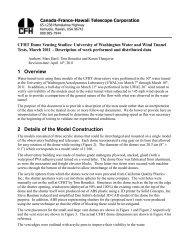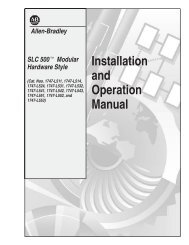Documentation [PDF] - Canada France Hawaii Telescope ...
Documentation [PDF] - Canada France Hawaii Telescope ...
Documentation [PDF] - Canada France Hawaii Telescope ...
You also want an ePaper? Increase the reach of your titles
YUMPU automatically turns print PDFs into web optimized ePapers that Google loves.
Each tile is centered at a well-defined position. The coordinates of a stack center position are identical<br />
for all filters. W1, W2, W3 and W4 are therefore composed of a complete set of u ∗ , g, r, i, y and z adjacent<br />
square tiles of 1 deg 2 each.<br />
The integer part of the center position of each tile is used to name the final stacks and other data products.<br />
This naming convention was agreed by CADC, Terapix and the CFHTLS Steering Group and is valid for<br />
all CFHTLS releases.<br />
In addition to the official astronomical CFHTLS naming convention, Terapix defined in 2002 a shorter<br />
naming convention based on a Cartesian grid coordinate system, where the increment unit is a MegaCamsize<br />
field and the center positions of the grid points are the center positions of the tiles 21 .<br />
The reference center of each Wide field of view is defined as the reference W[1, 2, 3, 4](0,0) and the<br />
Cartesian field names increase toward the East and North. The tiling and field naming conventions are<br />
drawn on Fig. 20 and the complete list of the T0007 Wide stacks is given in Tables 31.<br />
The total exposure time per filter is approximately the same for each tile (see Table 31 and the synoptic<br />
table). For some tiles, the exposure time is longer than the nominal value, because exposures that were<br />
considered out of spec by QSO and hence immediately reobserved have been later on salvaged at the post<br />
processing time. It produces very sharp exposure time distributions for all filters (see Fig. 23). Some<br />
observations have been adjusted to take into account unexpected events (like absorption by clouds/cirrus<br />
or technical problems). There are a few fields that have deeper u ∗ -band and z-band exposures which<br />
explains the small tails shown in the inset of Fig. 23. These longer exposures were taken before it was<br />
decided to cut the u ∗ and z exposure times by a factor of two at the survey mid-term review (2005).<br />
In addition to the original CFHTLS exposures, the VIPERS consortium took complementary exposures<br />
to fill in the holes in W1 which were caused by malfunctioning CCDs later in 2003. These images<br />
(distributed in 6 pointings and three filters u,g and y) have been added to T0007. As a result, these<br />
pointing are deeper than the rest of the survey. A detailed description of the added VIPERS-DDT images<br />
can be found in Table 5. Their position on the W1 patch are shown in Figure 22.<br />
Wide position Filter Exposure time (per image) Number of exposures<br />
[s]<br />
W1+2+2 u.MP9301 600 6<br />
W1+4+2 g.MP9401 290 7<br />
W1+3+1 g.MP9401 290 5<br />
W1+3+1 g.MP9401 290 5<br />
W1+4+1 g.MP9401 290 5<br />
W1+2+1 i.MP9702 300.096 7<br />
W1+3+2 i.MP9702 300.092 5<br />
Table 5: Description of the 40 additional VIPERS-DDT images.<br />
All r-band stacks combine data taken during two epochs separated by at least two years and totalling<br />
21 http://terapix.iap.fr/cplt/oldSite/Descart/summarycfhtlswide.html<br />
32


![Documentation [PDF] - Canada France Hawaii Telescope ...](https://img.yumpu.com/26965302/44/500x640/documentation-pdf-canada-france-hawaii-telescope-.jpg)









